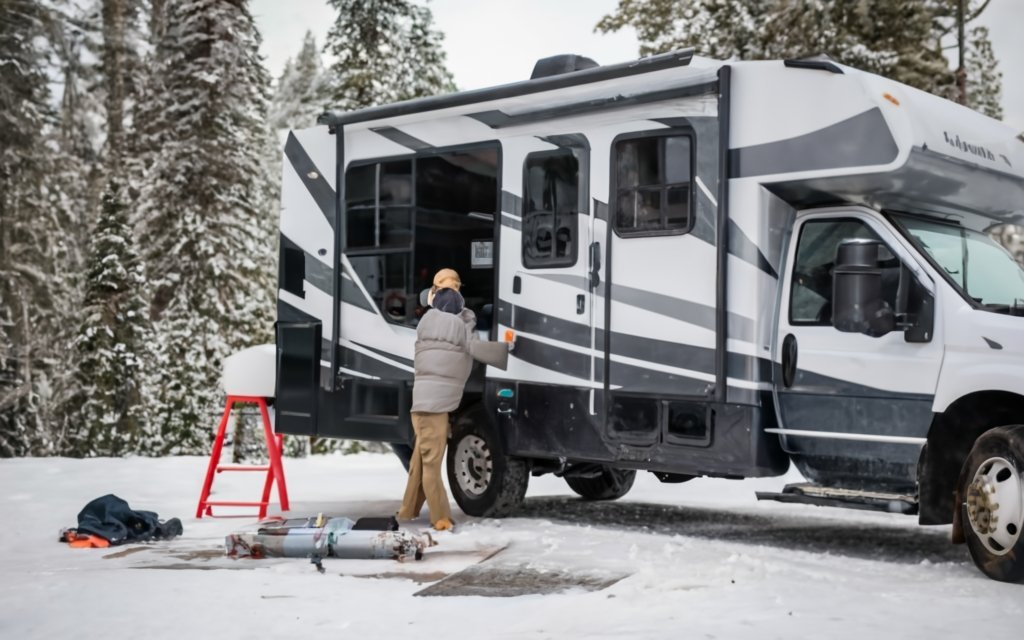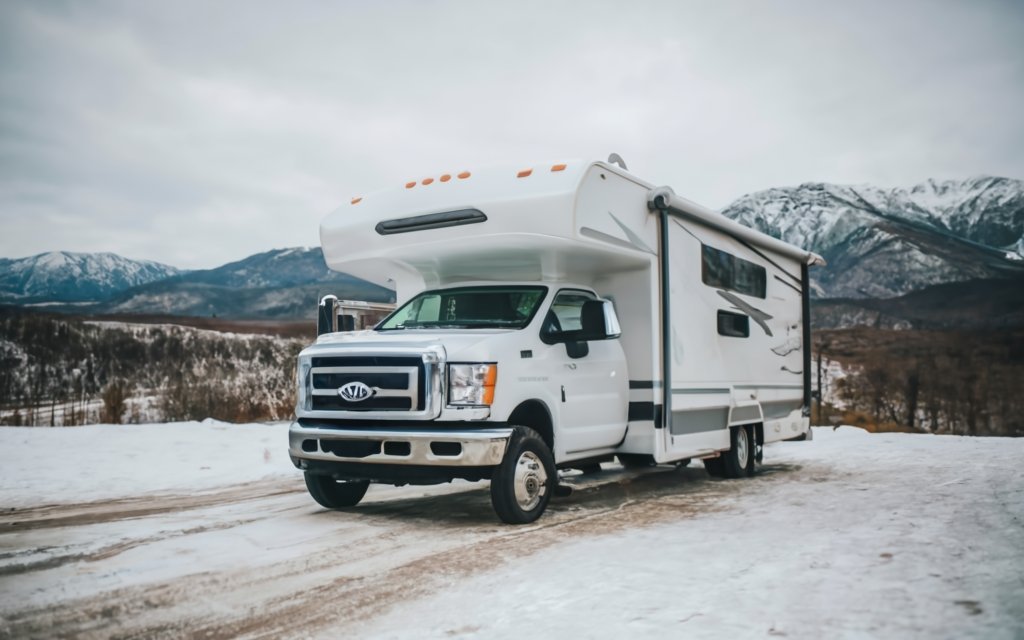Winterizing your RV is crucial to prevent costly damage from freezing temperatures and ensure a smooth start to your next adventure. Here’s a comprehensive guide to get you prepped:
Essentials:
- Drain and fill:
- Freshwater system: Disconnect and drain all water lines, faucets, and tanks. Use compressed air to blow out any remaining water from pipes. Add non-toxic RV antifreeze to freshwater tanks and lines according to the manufacturer’s instructions.
- Wastewater system: Drain your black and gray water tanks completely. Consider adding RV antifreeze to traps and drains to prevent freezing.
- Plumbing:
- Open low-point drains on your water heater and any other water fixtures to allow residual water to escape.
- Close and bypass the water heater to prevent unnecessary heating of antifreeze.
- Appliances:
- Empty and clean out your refrigerator, freezer, and any other water-using appliances. Leave doors slightly ajar to prevent mildew growth.
- Exterior:
- Seal any cracks or gaps around windows, doors, and vents with weatherproofing tape to prevent drafts and leaks.
- Cover exposed plumbing lines and pipes with insulating foam or heat tape to avoid freezing.
- Lubricate all door and window hinges to prevent sticking in cold weather.
- Battery:
- Disconnect and store your RV battery in a warm, dry place if you won’t be using it for an extended period. Alternatively, use a battery maintainer to keep it charged.
- Tires:
- Check and adjust tire pressure to the manufacturer’s recommendations for cold weather. Consider using tire covers to protect them from sun damage and cracking.
Bonus tips:
- Roof: Inspect your RV roof for any leaks or potential damage and repair them before winter. Consider adding RV roof snow covers to prevent excessive snow accumulation.
- Engine: Change your engine oil and coolant to winter-grade fluids suitable for the expected coldest temperatures.
- Generator: If you have a generator, winterize it according to the manufacturer’s instructions, including draining fuel and antifreeze procedures.
- Leveling: Consider leveling your RV slightly towards the rear to allow melted snow or rainwater to drain properly.
But First:
What Does Winterizing an RV Mean?
Winterizing an RV is the process of preparing your trusty home on wheels for the cold weather months. It’s essentially about protecting your RV’s plumbing, appliances, and other systems from the potentially damaging effects of freezing temperatures.
Here’s a breakdown of what winterizing typically involves:
1. Draining the water system: This is crucial to prevent pipes from bursting. You’ll drain all freshwater tanks, lines, and fixtures, and even use compressed air to blow out any remaining water droplets.
2. Adding antifreeze: To further protect against freezing, you’ll fill freshwater tanks and specific lines with RV-safe antifreeze, creating a liquid barrier that won’t freeze even in the coldest weather.
3. Addressing the wastewater system: You’ll empty black and gray water tanks, and might consider adding antifreeze to traps and drains for extra protection.
4. Preparing appliances: Emptying and cleaning refrigerators, freezers, and water-using appliances is important to prevent mold growth and ensure proper drying during winter storage.
5. Sealing and insulating: Closing windows and vents securely, sealing any cracks or gaps, and covering exposed plumbing lines with insulating foam or heat tape helps keep the cold out and prevents drafts.
6. Battery and tire care: If you won’t be using your RV, disconnecting and storing the battery in a warm place or using a battery maintainer is recommended. Checking and adjusting tire pressure to cold weather recommendations is also important.

7. Additional steps: These may include inspecting and repairing the roof, leveling the RV for proper drainage, and placing moisture absorbers inside to combat humidity buildup.
By following these steps, you can help ensure your RV survives the winter unscathed and is ready to hit the road again when the warmer weather arrives. Remember to consult your RV’s owner’s manual for specific instructions and recommendations based on your model and features.
So, in essence, winterizing your RV is like putting it into a warm, protective hibernation so it can wake up happy and healthy in the spring. And trust me, a little effort now can save you a lot of headaches and potential repairs later!
Winterizing Your RV: Don’t Let Jack Frost Bite Your Home on Wheels.
Hey fellow road warriors, buckle up! As the mercury dips and leaves start to crunch, it’s time to face the inevitable: winterizing your RV. Believe me, I’ve seen the frosty aftermath of skipped steps – cracked pipes, exploded water heaters, moldy interiors – it ain’t pretty. But fear not, adventurers! I’m here to guide you through the process like a seasoned sherpa, sharing my hard-won wisdom and expert tips to ensure your RV sleeps soundly through the winter and wakes up ready to roll come spring.
Part 1: The Chilling Truth About Skipping Winterization.
Imagine this: you return from a cozy holiday break, keys jingling with excitement, only to find your beloved RV transformed into a frozen wasteland. Burst pipes spew icy tears, a symphony of cracks echoing through the chassis. Mold spores pirouette in the dim light, and the scent of damp despair hangs heavy. Nightmare, right?
That’s the harsh reality of skipping winterization. Don’t underestimate the wrath of Mother Nature. Freezing temperatures turn your once-joyful plumbing lines into ticking time bombs, waiting to unleash a torrent of expensive repairs. Water heaters become brittle grenades, ready to explode with a frosty bang. And let’s not forget the insidious creep of mold, silently feasting on your RV’s cozy corners.
But fear not! A little TLC now saves you heartache and cash later. Winterizing is your RV’s winter coat, an armor against the icy clutches of winter. So grab your tools, channel your inner MacGyver, and let’s get prepped!
Part 2: Gearing Up for the Winterization Battle.
Before we dive into the nitty-gritty, let’s assemble our arsenal. Here’s the essential kit to conquer winterization:
Table 1: Winterization War Chest
| Weapon | Description |
|---|---|
| RV Antifreeze (non-toxic!) | Your secret weapon against frozen pipes. Choose the right type for your climate. |
| Compressed Air | Blows out pesky water hiding in those sneaky lines. |
| Pump Sprayer | Makes applying antifreeze a breeze (think water gun, but way cooler). |
| Bucket | For catching expelled water – think of it as a victory trophy. |
| Gloves and Eye Protection | Safety first, folks! Antifreeze ain’t your friend if it gets in the wrong places. |
| Weatherproofing Tape and Caulk | Seals those pesky cracks like a frosty bouncer. |
| Leveling Blocks | Keeps your RV balanced, ensuring proper drainage (think happy, unstressed pipes). |
| Extra Towels and Sponges | Mopping up any spills is part of the winterizing victory dance. |
Bonus Tip: Consult your RV’s owner’s manual for specific winterization instructions. It’s like a personalized battle plan for your unique rig.
Remember, proper preparation is half the battle. With your tools at the ready and the manual your guide, you’re one step closer to a stress-free winter slumber for your RV. Stay tuned for Part 3, where we’ll roll up our sleeves and tackle the freshwater system like seasoned plumbers!
Conquering the Freshwater Frontier: Taming the Pipes and Tanks.
Alright, adventurers, we’ve gathered our gear and faced the frosty truth. Now, it’s time to roll up our sleeves and dive into the heart of winterization: the freshwater system. Think of it as a network of veins pulsing through your RV, and we’re about to give them a much-needed winter tonic – antifreeze! But before we unleash the magic potion, let’s drain the lifeblood of potential disaster: water.
A. Draining the Dragon: Evicting Every Drop
- Disconnect and Drain: First things first, sever the connection to any city water or campground hookups. Think of it as cutting off the faucet at the source. Now, locate those low-point drains – tiny heroes hiding under your RV, just waiting to be unscrewed. Let gravity do its thing, watching with satisfaction as water gurgles out, carrying away potential freeze threats. Don’t forget faucets, showers, and the toilet (remember, even Poseidon needs a winter break!).
- Open the Floodgates: Unleash the hidden water warriors hiding in your tanks. The freshwater tank and water heater have their secret spigots, so twist them open and let the liquid escape. Patience is key! Some tanks might be slowpokes, taking their time to empty.
- Compressed Air Cavalry: Blasting Out the Remnants: Even the bravest warriors leave stragglers behind. That’s where compressed air comes in, your trusty steed against sneaky water droplets. Attach a blow-out plug to a faucet (think of it as a mini trumpet for expelling air) and blast those lines clean. Listen for the satisfying hiss – it’s the sound of victory!

B. Antifreeze Armada: Deploying the Winter Guard.
Now, for the pièce de résistance: antifreeze! Remember, not all heroes wear capes; some come in gallon jugs. Choose the right type for your climate (consult your manual, it’s your trusty map!). Here’s how to unleash the Winter Guard:
- Pump Power: The easiest way to fill your freshwater tank is with a hand pump. Connect it to the antifreeze jug and get pumping! Think of it as a frosty milkshake, only sweeter (don’t drink it!). You can also use the onboard pump, but follow your manual’s instructions to the letter.
- Gravity’s Grip: No pump? No worries! Gravity’s your buddy. Simply pour antifreeze directly into faucets or the city water connection point, letting it flow through the lines like a pink (or blue, depending on your antifreeze’s color) river. Watch for it spilling out of low-point drains – that’s your signal the lines are full.
- Don’t Forget the Traps!: Those little U-bends under sinks and showers are sneaky water havens. Pour a cup of antifreeze directly into them to keep them happy and freeze-free.
C. Closing the Curtains: Securing the Pipes and Tanks.
With the antifreeze guard in place, it’s time to button things up:
- Close all faucets and drains. Think of it as saying “goodnight” to potential leaks.
- Bypass the Water Heater: No need to waste antifreeze in your water heater’s belly. Follow your manual’s instructions on closing the bypass valve, sending the pink (or blue) river on a detour.
- Drain the Hot Water Heater: Don’t leave any water lurking in the heater’s depths. Open the drain valve and let it flow freely, like tears of frozen joy.
Remember: This is just the freshwater system! Stay tuned for Part 4, where we’ll tackle the wastewater beast and other winterizing essentials. Keep those tools handy, and your RV will be thanking you come spring!
Taming the Wastewater Titan and Beyond: Winterizing Every Nook and Cranny.
Alright, intrepid travelers, we’ve conquered the freshwater frontier, but the icy battle still rages! Now, it’s time to face the dreaded wastewater system – a behemoth that demands respect. But fear not, for with the right tactics and a touch of elbow grease, we’ll leave it tamed and slumbering through the winter.
A. Banishing the Black and Gray Beasts:
- Empty those Tanks: Let gravity be your ally once more. Open the black and gray water tank valves, and watch those beasts drain away, taking their stinky potential for winter trouble with them. Consider using sewer hose attachments and flushing tools for a thorough cleansing.
- Antifreeze or Not? This is where opinions clash like titans. Some say to add a splash of RV antifreeze to traps and drains to prevent freezing (think of it as a frosty moat). Others argue it’s unnecessary and can attract critters. Weigh the pros and cons, consult your manual, and choose your weapon wisely.
B. Sealing the Cracks: Fortifying Your Castle Against Drafts and Leaks
Winter isn’t just about water; it’s about wind too. So grab your trusty weatherproofing tape and caulk – your medieval siege weapons against drafts and leaks. Seal any cracks or gaps around windows, doors, and vents, ensuring your RV stays cozy and dry throughout the winter. Don’t forget those vulnerable plumbing lines and pipes – wrap them in insulating foam or heat tape like knights in wintery armor.
C. Tire TLC: Keeping Your Rolling Castles Steady
Your tires are the unsung heroes of your RV, and winter takes its toll. Check and adjust tire pressure to the manufacturer’s recommendations for cold weather – think of it as pumping up their winter resilience. Consider tire covers to protect them from sun damage and cracking, keeping them ready to roll come spring.
D. Battery Blues: Keeping Your Power Core Alive
If you won’t be using your RV for an extended period, disconnect and store your battery in a warm, dry place. Think of it as giving it a cozy hibernation spot. Alternatively, use a battery maintainer to keep it charged – like a loyal squire tending to the power source.
E. Leveling Up for Optimal Drainage:
A slightly rearward tilt keeps your RV happy during its winter slumber. Think of it as giving it a good posture to ensure proper drainage and prevent pooling water woes. Leveling blocks are your trusty jacks, helping you achieve that perfect winter stance.
Bonus Tip: Don’t forget the roof! Inspect it for potential leaks and repair them before winter unleashes its fury. Think of it as patching up any weak spots in your castle’s defenses.
Bonus Booty and Beyond Conquering Winter Like a Pro.
Alright, champions of winterizing, we’ve slain the plumbing dragons, tamed the wastewater titan, and fortified our rolling castles against the icy onslaught. But the journey doesn’t end there! Let’s unlock some bonus booty and wrap up this adventure with invaluable resources to ensure your RV sleeps soundly through the winter like a frost-free warrior.
VII. Bonus Strategies for the Cunning Conqueror:
- Appliance Apathy: Give your refrigerator and other water-using appliances a winter break. Empty, clean, and leave doors slightly ajar to combat mold. Think of it as giving them a well-deserved vacation.
- Interior Insulation: Don’t let the cold creep in! Throw in some blankets, pillows, or other soft items to provide extra insulation and prevent condensation buildup. Consider closing off unused areas with curtains or dividers.
- Moisture Mayhem: Humidity is winter’s hidden enemy. Place moisture absorbers strategically throughout your RV to battle this foe. Silica gel packets or commercial dehumidifiers can be your secret weapons.
- Critter Calamity: Keep those furry (or feathery) fiends at bay! Seal any potential entry points and consider placing traps or deterrents near the RV. Remember, a well-defended castle keeps unwanted guests out.
- Springtime Surprise: Leave yourself a note! List any hidden switches, valves, or instructions you might forget come spring. Think of it as a treasure map leading to a smooth RV thaw.
VIII. Resources for the Ready Rider:
- RV Owner’s Manuals: Your gospel for specific winterizing instructions and specs. Treat it like a sacred scroll!
- RV Forums and Communities: Connect with fellow adventurers, share tips, and get answers to your burning winterizing questions. Remember, knowledge is power (and camaraderie is fun!).
- RV Winterizing Checklists: Find printable guides online to keep track of your progress and ensure no step is left unfrozen. Think of it as a battle plan checklist!
- Professional RV Service: If DIY isn’t your jam, enlist the help of experienced RV technicians. Consider it calling in the cavalry for a guaranteed winter-ready victory.

Remember: Winterizing is an investment in your RV’s future. By putting in the effort now, you save yourself time, money, and heartache come spring. So channel your inner winter warrior, follow these tips and resources, and watch your RV slumber peacefully through the frosty months, ready to roll again when the sun thaws the land. Until then, happy winterizing, adventurers!
With this final chapter, we’ve conquered the icy frontier and prepared your RV for a cozy winter slumber. Go forth, adventurers, and may your journeys be frost-free and your springs joyful! Remember, winterizing is a skill, not a chore. Embrace the challenge, share your knowledge, and help others keep their rolling castles safe and sound. Until next time, happy travels!
Remember: This is just the tip of the winterizing iceberg! Consult your RV’s manual for specific instructions and tailor your winterizing to your unique rig. Stay tuned for Part 5, where we’ll unlock some handy bonus tips and wrap up this journey with some helpful resources to keep your RV safe and sound until spring.

Welcome to the enchanting world of Genah Reney, the esteemed Author-in-Residence at BAF TOURS International. Genah is not only a master storyteller but also a guiding force in weaving narratives that elevate the travel experience. Her literary prowess mirrors the essence of BAF TOURS, creating a seamless blend of captivating stories and the allure of global exploration.






